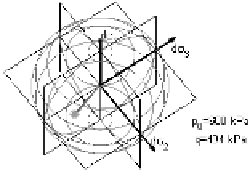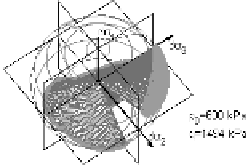Geoscience Reference
In-Depth Information
226
Multiscale Geomechanics
d
σ
1
d
σ
1
d
σ
3
d
σ
3
p
0
=600 kPa
q=640 kPa
p
0
=600 kPa
q=494 kPa
η
=0.646
d
σ
2
η
=0.787
d
σ
2
d
σ
1
d
σ
1
d
σ
3
d
σ
3
p
0
=600 kPa
q=1494 kPa
η
=1.361
p
0
=600 kPa
q=1544 kPa
d
σ
2
d
σ
2
η
=1.385
(a)
(b)
Figure 8.3.
3D instability cones for a dense Hostun sand. The Figure 8.3(a) displays cones
obtained with the octolinear model. Planes delineate the eight tensorial zones, meshes
correspond to the analytical solution of equation [8.8] and point clouds to solution obtained
with a numerical method. The Figure 8.3(b) shows results obtained with the non-linear model
with the numerical method.
p
o
is the initial confing pressure,
q = σ
1
− σ
3
,
η =
q
p
according to Darve's models [DAR 95]. Without entering into the details involving
these models, let us just remark that they are not based on the classical concept of
elastoplasticity: no hypothesis has been made on strain decomposition into elastic and
plastic part and no loading surface and flow rule have been defined. The irreversible
non-linear behavior is directly described by a phenomenological incrementally non-
linear relation. Relationships have been developed to describe triaxial loading paths
on granular materials, after which the behavior in other loading directions has been
extrapolated by one of the two following relations:
⎡
⎤
⎦
=
1
2
⎡
⎤
⎡
⎤
dσ
1
dσ
2
dσ
3
dε
1
dε
2
dε
3
dσ
1
dσ
2
dσ
3
N
+
+ N
−
N
+
− N
−
1
2 dσ
⎣
⎣
⎦
+
⎣
⎦
[8.12]
where matrices
N
+
and
N
−
have the same shape as
N
in equation [8.5]. Exponents +
and
−
allow us to distinguish tangent Young's moduli and tangent Poisson ratios
in compression and extension, respectively. With this mathematical formulation, a
different material behavior is obtained for each stress rate direction. This model is
called INL for incrementally non-linear. The second model is based on the same
formulation as the INL, but with a simpler interpolation relation, which corresponds

































Search WWH ::

Custom Search